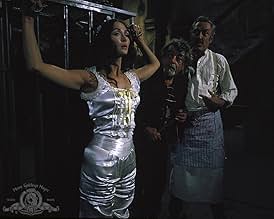Füge eine Handlung in deiner Sprache hinzuParis...at the turn of the century. Inspector Vidocq investigates a series of unexplained murders at a Grand Guignol-type theatre...where the players have suddenly become real-life victims. ... Alles lesenParis...at the turn of the century. Inspector Vidocq investigates a series of unexplained murders at a Grand Guignol-type theatre...where the players have suddenly become real-life victims. Based on the story by Edgar Allan Poe.Paris...at the turn of the century. Inspector Vidocq investigates a series of unexplained murders at a Grand Guignol-type theatre...where the players have suddenly become real-life victims. Based on the story by Edgar Allan Poe.
- Regie
- Drehbuch
- Hauptbesetzung
- Gabrielle
- (as Rosalind Elliott)
- Madam Adolphe
- (as Maria Martin)
- Member of Repertory Company
- (as Rafael Hernandez)
Empfohlene Bewertungen
A truly international production, with cast & crew coming from all over the world, this adaptation of Poes' work tells a decent enough story, but a foregone conclusion REALLY takes the edge off the "mystery". Robards is badly miscast (although even he felt so), and gives one of the lesser performances of his career. Not that much of the cast really do their best work here, anyhow. Still, Celi is fun, and the lovely Christine Kaufmann ("Town without Pity") is appealing as the ingenue of the tale. Michael Dunn ('The Wild Wild West') is amusing, as always, and Herbert Lom ("The Dead Zone") is fairly menacing, but even the antagonist that he plays isn't one of his more memorable. The abrupt ending isn't particularly satisfying.
It's really the "bells & whistles" of this production that make it as watchable as it is: the production design and cinematography are effective, and the film gets a really nice music score from Waldo de los Rios.
Although set in Paris, this was actually filmed in Spain. And that's a very young Brooke Adams ("Days of Heaven"), in her uncredited film debut, playing the nurse.
Six out of 10.
The plot is set in nineteenth century Paris around a theater troop resembling the historic Grand Guignol theater and is similarly specialized on cruel natured horror plays. The certain theatricality follows everywhere the story takes us and stays in the actors even when they are not on stage. The streets are crowded with a carnival and merry-go-rounds. There is a puppet theater, tricks and hypnotism. Even the real murders are executed in most showy ways. The atmosphere has a dreamy, almost surrealistic quality. And the actual dream sequences (What's a Poe film without them?) are beautifully shot and tinted in red tones. Very beautiful and creepy all at the same.
For an American horror production the film has a surprisingly bright European art film look and feel. Instead of using wholly dramatic studio sets we are treated with daylight locations, streets and parks, which allows the movie breath a bit between the expected horrors. This production was a pleasant surprise from Gordon Hessler and American International and a refreshing addition to their line of earlier Poe films directed by Roger Corman.
There are so many complex scenes, so many amazing sets and costumes, and lots of moving camera that implies intelligent filmmaking it's a miracle this film came out so wooden. And frankly boring.
Part of the problem is Jason Robards in the lead--another actor might have pulled off the drama and intrigue anyway. And the leading victim-female is almost terrible--Christine Kaufmann. But the director, Gordon Hessler, I think gets the worst of everyone, and all this apparent money and talent is squashed under bright even light and uninspired performances.
There are lots of horror film clichés that might be satisfying to some, including just the use of the theater as a set (somewhat like Phantom of the Opera). But some of the clichés are cheezy 1971 versions, like dreamy sequences with double exposures or slow motion, and strange sound effects of choral voices.
There were enough people who really liked this movie for the director to mades an official director's cut with eleven extra minutes. Well, why not? It's all voluntary, and I'd vote against it unless you are really into the themes here, the actors, or just have a lot of time free and here it is. It's no awful, it's just slow and clunky. And why did they film it with such shadlowless flat bright light? It's a horror film, for goodness sake.
The main problem with this movie lies in casting Jason Robards in the role of Cesar Charron. He's not a horror actor and is completely out of his element (drama). The obvious choice for such a role would have been Vincent Price, who would have torn into it with gusto. Robards, a fine actor otherwise, comes off as languid and disinterested.
On the upside, the manner of the homicides is novel, and though the story is quite padded out, it does lead up to a decent twist at the end...
Wusstest du schon
- WissenswertesIn an interview included on the movie's the DVD, director Gordon Hessler said that he thought the majority of people knew the ending of the source short story (the film is a remake and had been shot more than once before), so Hessler thought he would re-imagine the story, and as such introduced new story elements.
- PatzerJust before a performance, Charron tells his wife to "break a leg." That very American expression originated in the 1920s, and thus certainly would not have been spoken in 19th-Century Paris.
- Zitate
Rene Marot: Yes, Madeleine. There stands the axe-man of your dreams.
- VerbindungenFeatured in Deadly Earnest's Nightmare Theatre: Murders in the Rue Morgue (1978)
Top-Auswahl
- How long is Murders in the Rue Morgue?Powered by Alexa
Details
Box Office
- Budget
- 700.000 $ (geschätzt)






















